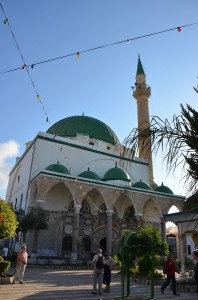Jewish/Zionist Sites
Kibbutz Yad Mordechai
Yad Mordechai takes its name from Mordechai Anielewicz, the hero of the Jewish Warsaw Ghetto uprising against the Nazis during the second world war. The kibbutz founders, like Anielewicz, originally hailed from Poland. During the Israeli War of Independence this kibbutz was located along the road of the Egyptian army’s main advance. For several days the badly outnumbered defenders of the Kibbutz, which consisted of Kibbutz men and haganah soldiers, managed to hold off the enemy’s onslaught. Finally after five days the defenders had no choice but to vacate the community. But their resistance had won for the Israeli forces valuable time to prepare and as the Egyptians continued their drive north towards Tel Aviv they were stopped at Ad Halom a few days later. The Egyptians were finally pushed back to what came to be known as the Gaza Strip which they occupied until the Six Day War.
Ayalon Institute (bullet factory)
Tel Aviv
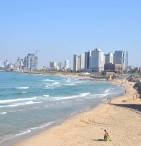
There’s a joke we like to tell. If you have just two days to spend in Israel, spend one in the holy city of Jerusalem and one taking in the unencumbered vistas of the Galilee, its lake and the Golan. But if you have three days here, forget all of that, and spend all of your time in Tel Aviv.
Tel Aviv, founded on sand dunes by 66 pioneering Jewish families in 1909 is Israels commercial and artistic capital, a place where every young Israeli yearns to live. A liberal city with miles of white sandy beaches and culture to match, this is the place for a Mediterranean vacation!
Old Jaffa
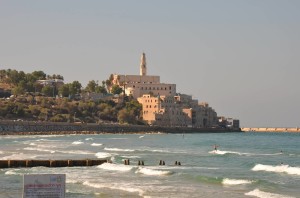 The port of Jaffa dates back thousands of years, and it served as the escape route in the biblical story of Jonah and the whale as Jonah tried to evade God’s command for him to preach repentance to the inhabitants of Ninveh. For millennia Jaffa was the traditional entry point to the Land of Israel and the holy city of Jerusalem. Today one can visit the hilltop overlooking the Sea and note evidence of Greek, Roman, Arab and European civilizations before walking the town’s alleys and visiting its artist colony.
The port of Jaffa dates back thousands of years, and it served as the escape route in the biblical story of Jonah and the whale as Jonah tried to evade God’s command for him to preach repentance to the inhabitants of Ninveh. For millennia Jaffa was the traditional entry point to the Land of Israel and the holy city of Jerusalem. Today one can visit the hilltop overlooking the Sea and note evidence of Greek, Roman, Arab and European civilizations before walking the town’s alleys and visiting its artist colony.
Acre
Traditionally Acre was the important town in Israel’s north. It was a critical life-line to Europe for the Crusaders in the Middle Ages. Recently discovered Crusader remains are a highlight of the trip to Acre where we’ll explore secret passages, the Knight’s Halls, the Arab market and the port area.
Safed: Artist’s Colony and Synagogues
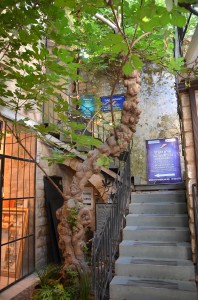
The Fig Tree Courtyard, so named for the Fig tree which has been nursed back to health by local developers now is home to several art galleries. Formerly it was a family residence and it still contains a water cistern, visible in the courtyard.
Don’t miss Safed! Whether it’s the mountain air, the insights into Jewish mysticism, the unique synagogue architecture or the unparalleled art and Judaica, everyone enjoys walking the stone covered alleys of this Upper Galilee town.
We’ll descend past Messhiah’s Alley, find our favorite eatery in the square, and then descent towards the Ashkenazi Ari synagouge. After stopping there to gain insight into Kabbala (Jewish mysticism) we continue towards the art colony and visit the Abuhav Synagogue as well. Here in the middle of the 16th century a Jewish community flourished and set an example due to its caring nature and it’s scholarship in practical halakha (Jewish Law) as well as the 1900 year old Kaballa.
The Fig Tree Courtyard, see photo above, is named for the Fig tree which has been nursed back to health by local developers. The courtyard is now home to several art galleries. Formerly the site was a family residence and it still contains a water cistern, visible in the courtyard.
Capernum
Capernum is the place to come when you want to see how cultures borrow from each other. It’s a confusing place. Forunately we can make some sense of it while we sit in the shade under the large shade-giving trees that grow next to the sites ancient synagogue.
Back in the days of Jesus this place was a mid-sized fishing town of some 1500 people. Certainly large enough to merit having it’s own synagogue. In that time synagogues were used as places of congregation by the community, places to learn and make decisions. A couple of generations later, after the destruction of the great Temple in Jerusalem they would begin to function as places of worship to the God of Israel, since the option of making pilgrimage to the Temple was no longer a possibility.
Here look at how the Jews of the Byzantine era decorated their synagogue, what evoked their pride. When we enter the synagogue do we feel like we’ve been in this type of building before? Even if we’ve never been in a synagogue before, it seems familiar to us. Why?
We pass by the remnants of original neighborhoods from 2000 years ago and arrive at the original home of St. Peter, where Jesus lived during his ministry. It sits under the modern church. Consider this small space and learn about why it had to be so small, then how it was enlarged.
Before leaving look at the statue of St. Peter and try to identify the symbols that confirm for us that the figure is indeed Peter.
Tzippori (Sepphoris)
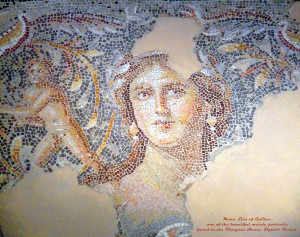
The so-called :Mona Lisa of the Galilee” can be seen in the remains of a mansion situated on the highest hill in ancient Tzipori.
Jewish sources claim that Tzipori, which means bird in Hebrew, gets its name because the town soars from its position like a bird on the top of a hill. Roman aquaducts, beautiful mosaics from a wealth of cultures, a synagogue with both Jewish and pagan themes in its floor mosaic, an amphitheatre and Roman Cardo combine to make this Lower Galilee a source of fascination for lovers of anitquity. Tzipori revolted against King Herod in the first century BC and paid a terrible price. But Tzipori, a mixed Jewish and Pagan city wisely chose to sit out the Great Jewish Revolt against the mighty Romans in the first century. By the end of the second century it had become a preeminent site of Jewish scholarship; the most powerful Jew of the time, Rabbi Yehuda HaNasi chose to make this his home as he edited the Oral Law (Mishna) first handed down in part at Mt. Sinai to Moses, 1450 years before. A Christian tradition places the birth of Mary, mother of Jesus, here. The site is only six kilometers from the hometown of Jesus, Nazareth, and scholars hypothesize that Joseph would take a young Jesus with him to work on building projects in the bustling town, over the ridge from tiny Nazareth.
Bet Shearim
Chiseled into the white chalk rock at the edge of the lower Galilee, Bet Shearim stands as a testament to the Jewish people’s attachment to the land of their forefathers. Bet Shearim is filled with expensive sarcophagi belonging to wealthy Jews from far and wide. Diaspora Jews who could not or would not come to spend their living days in the Holy Land often chose to spend eternity buried in it and the result are splendid relics, found here, from the 2nd to the 4th centuries. One of Judaism’s most important scholars, Rabbi Yehuda HaNasi (Judah the Prince) who edited the Mishnah, is buried here and this only added to the prestige of the site in Talmudic times.
Tel Dan
Tel Dan is the ideal destination in the north. It’s got it all: biblical archeology, water, trails, beauty, a view of Lebanon and an important piece of the history leading up to the Six Day War. It’s also close to excellent eateries. Try not to miss Dan.
How to put together your Water and Wine tour of Israel
On our Water and Wine Tours website you will not find standard tours.
Don’t worry. We’ll make sure that you experience the must-see sites in the country. But we’ve also included a comprehensive list of sites, by region for people with many different interests, with enough description for you to ascertain whether it’s the sort of place you want to spend your time.
You know your budget and how much time you have to spend here.
So here are our recommendations, based on years of leading all sorts of tours throughout the country.
- Ask yourself if this trip is a vacation. Do you want to see sites but also feel really relaxed at the end of each day? So that you don’t need a few days of sleep upon your return home? If this is the case then try to restrict yourself to three major sites per day. Between the sites, travel and lunch 8-10 hours will pass quickly.
- If you’re more inclined to describe yourself as a pilgrim or someone who wants a survey of sites, then expect to visit up to five sites per day. You’ll be spiritually satisfied but you’ll also need to get a good night’s sleep every night.
“A life changing event”
"Our guide, Zach Levin, made the trip a life changing event for both Linda and me. He was very sensitive to our needs and went out of his way to make sure we got the full Israeli experience. Zach is very knowledgeable and his passion and enthusiasm contributed to our getting the full flavor of the country."
Harvey and Linda W
Your Tour Guide
Water & Wine Tours specializes in individually tailored tours catering to the interests of its clients. Our founder, Zach Levin, is an experienced, licensed tour guide who majored in Middle Eastern Languages and Cultures at Columbia University in the City of New York.
Our tour guides make the history and culture of Israel come alive. They understand that the customer is always right and want you to experience an unforgettable Israel. We’ll take you to places which you’ll love and never forget. When you need to be left alone we’ll sense it. When you need an extra hand we’re there for you.

